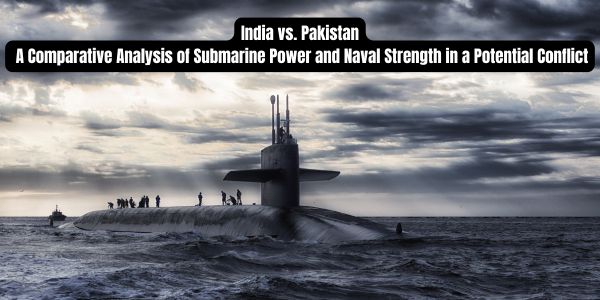The maritime rivalry between India and Pakistan, two nuclear-armed neighbors, is a critical aspect of their long-standing geopolitical tensions. As both nations bolster their naval capabilities, their submarine fleets play a pivotal role in shaping the strategic balance in the Indian Ocean Region (IOR). This article compares the submarine power of India and Pakistan, examining their capabilities, technological advancements, and potential outcomes in a hypothetical naval conflict.
India’s Submarine Fleet: A Diverse and Growing Force
India’s submarine fleet is one of the most formidable in South Asia, comprising both nuclear-powered and conventional submarines. As of April 2025, the Indian Navy operates 18 submarines, including two nuclear-powered ballistic missile submarines (SSBNs) and 16 diesel-electric submarines (SSKs).
- Arihant-Class SSBNs: India’s indigenous Arihant-class submarines, INS Arihant and INS Arighat, are equipped with K-4 ballistic missiles (3,500 km range) and K-15 Sagarika missiles (750 km range). These submarines form the sea-based leg of India’s nuclear triad, ensuring a second-strike capability. A third SSBN, INS Aridhaman, is expected to be commissioned by late 2025.
- Conventional Submarines: India operates five Kalvari-class (Scorpène) submarines, four Shishumar-class, and seven Sindhughosh-class (Kilo) submarines. These SSKs are equipped with torpedoes and anti-ship missiles, designed for anti-submarine warfare (ASW), anti-surface warfare, and intelligence gathering.
- Future Plans: India is developing six nuclear-powered attack submarines (SSNs) and has approved the construction of two additional SSNs with a budget of ₹40,000 crore. A lease for an Akula-class submarine, Chakra-III, from Russia is set for delivery in 2025.
India’s submarine fleet is supported by advanced naval infrastructure, including the INS Varsha base near Kakinada and the Karwar base, enhancing operational stealth and endurance.
Must Read: India’s Nuclear Submarine Power Bolsters Strategic Maritime Presence
Pakistan’s Submarine Fleet: Modernization with Chinese Support
Pakistan’s submarine fleet is smaller but undergoing significant modernization, primarily with Chinese assistance. The Pakistan Navy operates eight submarines, all of which are diesel-electric, with plans to expand to 11 by the early 2030s.
- Agosta 90B-Class: Pakistan operates three Agosta 90B submarines equipped with air-independent propulsion (AIP) systems, enhancing underwater endurance. These submarines carry Exocet anti-ship missiles and torpedoes, focusing on anti-surface warfare and coastal defense.
- Hangor-Class: Pakistan is acquiring eight Hangor-class (Yuan-class) submarines from China, with the first launched in May 2024. These AIP-equipped submarines feature advanced sensors and weapons, including the potential for nuclear-tipped Babur-3 submarine-launched cruise missiles (SLCMs) with a 450 km range, aiming to establish a sea-based nuclear deterrent.
- Midget Submarines: Pakistan has three Cosmo-class midget submarines for coastal defense, mine-laying, and special forces operations.
Pakistan’s submarines are based at Karachi Naval Dockyard and Jinnah Naval Base in Ormara, designed to counter potential Indian naval blockades.
Comparative Analysis: Submarine Capabilities
The following table summarizes the key differences between India’s and Pakistan’s submarine fleets:
| Aspect | India | Pakistan |
|---|---|---|
| Total Submarines | 18 (2 SSBNs, 16 SSKs) | 8 (All SSKs, 3 with AIP) |
| Nuclear Submarines | 2 SSBNs (Arihant-class), 6 SSNs planned | None |
| AIP Capability | None currently, planned for future SSKs | 3 Agosta 90B, 8 Hangor-class by 2030s |
| Nuclear Deterrence | K-4 (3,500 km), K-15 (750 km) ballistic missiles | Babur-3 SLCM (450 km, nuclear-capable) |
| Endurance | High (nuclear propulsion for SSBNs) | Moderate (AIP enhances SSK endurance) |
| Strategic Role | Second-strike capability, blue-water operations | Coastal defense, sea denial, tactical nuclear deterrence |
India’s Advantages: India’s nuclear-powered submarines provide unmatched endurance and stealth, enabling long-range operations and a robust second-strike capability. The Arihant-class SSBNs can target strategic locations deep inside Pakistan and parts of China, while India’s larger fleet and advanced ASW capabilities enhance its dominance in the IOR. India’s indigenous shipbuilding, led by Mazagon Dock and Cochin Shipyard, supports long-term fleet expansion.
Pakistan’s Strengths: Pakistan’s AIP-equipped submarines offer superior stealth for short-to-medium durations, ideal for coastal defense and sea denial strategies. The Hangor-class submarines, with potential nuclear-tipped SLCMs, aim to counter India’s conventional superiority through asymmetric tactics. Pakistan’s reliance on Chinese technology ensures rapid modernization.
Must Read: Explainer: How Nuclear Submarines Work
Naval Strength in a Potential Conflict
In a hypothetical naval conflict, several factors would determine the outcome:
- Fleet Size and Diversity: India’s navy, with 294 vessels including two aircraft carriers, 10 destroyers, and 20+ submarines, dwarfs Pakistan’s 109 ships, which lack carriers and rely heavily on submarines. India’s ability to project power across the IOR gives it a strategic edge.
- Submarine Warfare: India’s nuclear submarines can operate undetected for extended periods, posing a significant threat to Pakistan’s coastal assets. Pakistan’s AIP submarines are effective in shallow waters but are vulnerable to India’s ASW assets, including P-8I Poseidon aircraft and MH-60R helicopters.
- Nuclear Deterrence: Both nations possess sea-based nuclear capabilities, but India’s SSBNs offer a more survivable and far-reaching deterrent compared to Pakistan’s SLCM-equipped SSKs. This reduces the likelihood of nuclear escalation but complicates conventional warfare.
- Blockade Potential: India’s navy can enforce a blockade of Pakistan’s key ports, such as Karachi, disrupting its economy and military logistics. Pakistan’s submarines could harass Indian ships but lack the capacity for sustained offensive operations.
Outcome Assessment: In a conventional naval conflict, India’s superior fleet size, technological advancements, and strategic reach would likely overwhelm Pakistan’s navy. India’s ability to dominate the open ocean and sustain operations gives it a decisive advantage. However, Pakistan’s AIP submarines and nuclear-tipped SLCMs could inflict tactical losses, particularly in coastal waters, complicating India’s operations. A nuclear conflict would be catastrophic for both, with India’s second-strike capability ensuring mutual destruction.
Conclusion
India’s submarine and naval power significantly outmatches Pakistan’s, driven by its nuclear-powered fleet, larger numbers, and blue-water capabilities. Pakistan’s modernization efforts, particularly with AIP-equipped Hangor-class submarines, enhance its asymmetric capabilities but fall short of challenging India’s dominance. In a potential war, India’s navy would likely prevail in conventional scenarios, but Pakistan’s tactical nuclear options introduce risks of escalation. Both nations must prioritize diplomacy to avoid conflict in the volatile IOR.

